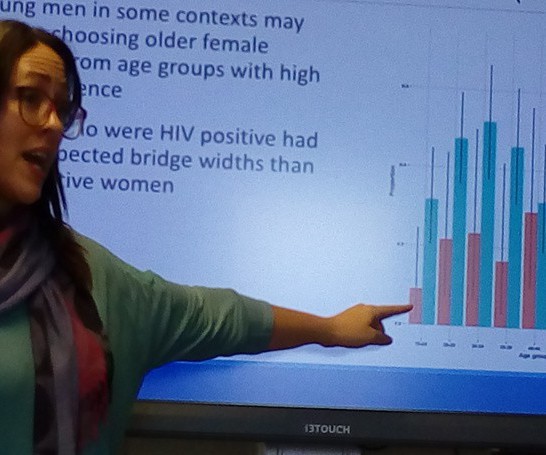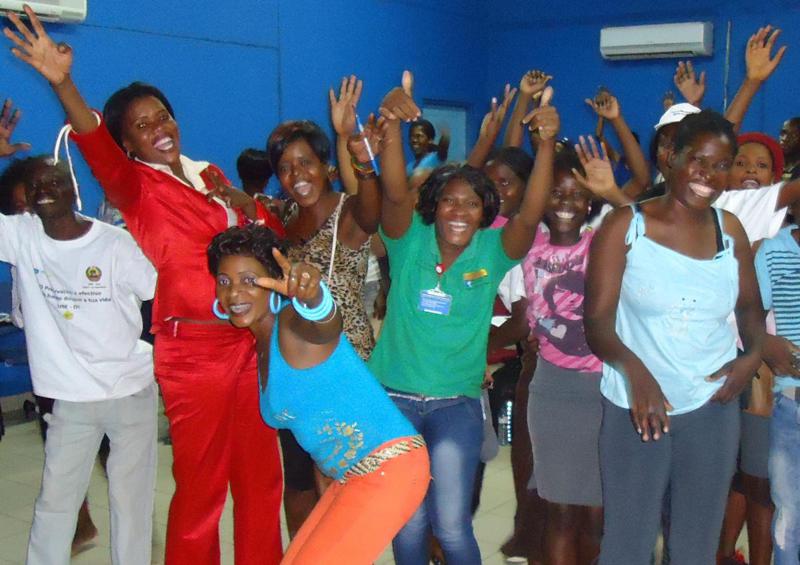Dr. Roxanne Beauclair successfully defended her PhD at Ghent University

On March 2nd 2018 Dr. Roxanne Beauclair successfully defended her PhD thesis entitled: 'Age Differences in Sexual Relationships and HIV Transmission: Statistical Analyses of Bio-Behavioural Survey Data from Southern Africa'.
Roxanne Beauclair
Defence venue March 2nd 2018 - 4:30 pm - Het Pand Gent
Supervisors Prof. dr. Wim Delva, Prof. dr. Niel Hens and Prof. dr. Marleen Temmerman
Thesis title: Age Differences in Sexual Relationships and HIV Transmission: Statistical Analyses of Bio-Behavioural Survey Data from Southern Africa
Full thesis: Click here
ABSTRACT
Southern Africa has an immense HIV epidemic marked by a disproportionate amount of new infections among adolescent and young adult women. The high prevalence of women engaging in age-disparate relationships – where men are five or more years older than women – has been suggested as a cause of young women acquiring HIV. Agedisparate relationships have been linked to inconsistent or less condom use in the relationship, multiple partner concurrency by the older male partner, higher sex frequencies, and alcohol use before sex. Moreover, in South Africa and Malawi HIV prevalence peaks in older age groups for men compared to women, implying that women who choose an older partner will have a greater likelihood of choosing an HIV infected partner. Compounding all of this, is the fact that younger women may be more susceptible to HIV infection than men and older women because they tend to have a different mucosal immune environment in their genitals and they are also prone to genital micro-abrasions. Despite these theorized mechanisms for how age-disparate relationships may cause HIV infection in young women, the epidemiological evidence has been inconclusive, with the most recent and best evidence suggesting there is no
relationship between age differences and incident HIV infection among young women.
There are several key limitations of previous work, that necessitated a closer investigation and new approach to studying age differences and HIV infection. Previous observational studies have not provided detailed descriptions of age-mixing patterns – population-level patterns for how people choose partners with regards to age – which may help to explain the magnitude and persistence of HIV in a population. Additionally, most studies have had serious methodological shortcomings, such as using face-to-face interviewing or only examining risk of HIV infection in the most recent sexual relationships. The former limitation may result in social desirability bias in reporting sexual behaviours, and the latter does not consider the risk of HIV posed by previous non-recent, age-disparate relationships. Finally, previous epidemiological studies have neglected to consider the agency of women in these relationships, and ultimately the role they might play in sustaining the HIV epidemic. To this end, this thesis explored new data from different South African and Malawian populations to evaluate whether age differences in sexual relationships have the potential to maintain the HIV epidemic in Southern Africa and augment the individual-level risk of acquiring HIV. I conducted one qualitative study consisting of in-depth interviews with key informants from Cape Town, as well as four secondary statistical analyses of data and from: Cape Town, South Africa (CAPS and CTSBS studies); Zomba, Malawi (SIHR study); and Likoma Island, Malawi (LNS study). Using this quantitative and qualitative data I: 1. Described and visualized age-mixing patterns in the CAPS, LNS, and CTSBS populations (Chapters 3, 5 and 7); 2. Identified socio-demographic predictors and psycho-social motivations for engaging in relationships with older men in the CAPS and CTSBS settings (Chapters 3 and 4); 3. Ascertained whether age differences in relationships were correlated with an individual’s HIV infection status in the LNS and CTSBS studies (Chapters 5 and 7), or other sexual risk behaviours commonly associated with increased HIV transmission risk in the CAPS, LNS, and SIHR populations (Chapters 3, 5 and 6). Where possible I attempted to address the limitations of previous studies by using data collected with state-of-the-art interviewing techniques, such as Audio Computer-Assisted Self-Interviewing, as well as advanced statistical techniques, like multivariate imputation by chained equations, generalized additive models, and mixed effects models. We found that large age differences in relationships were associated with less condom use in relationships (Chapters 3, 5, and 6), more frequent sex (Chapter 6), longer relationship durations (Chapter 6), and more reported STI symptoms (Chapter 3). Additionally, men who had a large range of age differences in the LNS population, were more likely to report having a concurrent relationship in the previous 3 years (Chapter 5). These sexual risk behaviours may put individuals at increased risk of HIV infection when they are in relationships with older partners. Indeed, in the two studies for which we had access to the HIV status of participants, we found a relationship between age differences and HIV infection. In the LNS study we observed that men, aged 18-49, who had relationships with older women were more likely to be HIV positive (Chapter 5). For women, aged 18-49, they had increasing probabilities of being HIV infected as the age differences grew from 2 to 12 years, but then they had decreasing probabilities of HIV
infection as the age differences grew larger. In the CTSBS population, women aged 15-70 who were HIV positive had nearly three times the expected range of partner ages, as those who were HIV negative (Chapter 7). At the population level, we observed that there was larger within-subject variation in age differences for women compared to men
in the LNS population (Chapter 5), and larger within-subject variation in age differences for HIV positive women compared to HIV negative women in the CTSBS setting (Chapter 7). The large variation in age differences for women may be an important characteristic of large, sustained HIV epidemics in Southern Africa.
Our study of the two Cape Town populations indicates that precarious and unstable home lives of young women, possibly characterized by absent parents, destitution, food insecurity, and intimate partner violence may be key determinants of women seeking relationships with older men (Chapters 3 and 4). Providing these young women with other forms of income through cash-transfers or state-sponsored grants may bring increased stability to young women, and eliminate the some of the motivation for relationships with older, riskier men who are likely to infect them (Chapter 6). By eliminating this transmission chain, there may be trickle-down effects to younger men, who will also be less likely to become HIV infected from their age-similar, or older, female partners.
Cash transfers are just one type of potential interventions that has the ability to prevent age-dependent chains of transmission. My research suggests other possible guidelines for future HIV prevention interventions related to age differences in relationships.
Interventions should:
Southern Africa has an immense HIV epidemic marked by a disproportionate amount of new infections among adolescent and young adult women. The high prevalence of women engaging in age-disparate relationships – where men are five or more years older than women – has been suggested as a cause of young women acquiring HIV. Agedisparate relationships have been linked to inconsistent or less condom use in the relationship, multiple partner concurrency by the older male partner, higher sex frequencies, and alcohol use before sex. Moreover, in South Africa and Malawi HIV prevalence peaks in older age groups for men compared to women, implying that women who choose an older partner will have a greater likelihood of choosing an HIV infected partner. Compounding all of this, is the fact that younger women may be more susceptible to HIV infection than men and older women because they tend to have a different mucosal immune environment in their genitals and they are also prone to genital micro-abrasions. Despite these theorized mechanisms for how age-disparate relationships may cause HIV infection in young women, the epidemiological evidence has been inconclusive, with the most recent and best evidence suggesting there is no
relationship between age differences and incident HIV infection among young women.
There are several key limitations of previous work, that necessitated a closer investigation and new approach to studying age differences and HIV infection. Previous observational studies have not provided detailed descriptions of age-mixing patterns – population-level patterns for how people choose partners with regards to age – which may help to explain the magnitude and persistence of HIV in a population. Additionally, most studies have had serious methodological shortcomings, such as using face-to-face interviewing or only examining risk of HIV infection in the most recent sexual relationships. The former limitation may result in social desirability bias in reporting sexual behaviours, and the latter does not consider the risk of HIV posed by previous non-recent, age-disparate relationships. Finally, previous epidemiological studies have neglected to consider the agency of women in these relationships, and ultimately the role they might play in sustaining the HIV epidemic. To this end, this thesis explored new data from different South African and Malawian populations to evaluate whether age differences in sexual relationships have the potential to maintain the HIV epidemic in Southern Africa and augment the individual-level risk of acquiring HIV. I conducted one qualitative study consisting of in-depth interviews with key informants from Cape Town, as well as four secondary statistical analyses of data and from: Cape Town, South Africa (CAPS and CTSBS studies); Zomba, Malawi (SIHR study); and Likoma Island, Malawi (LNS study). Using this quantitative and qualitative data I: 1. Described and visualized age-mixing patterns in the CAPS, LNS, and CTSBS populations (Chapters 3, 5 and 7); 2. Identified socio-demographic predictors and psycho-social motivations for engaging in relationships with older men in the CAPS and CTSBS settings (Chapters 3 and 4); 3. Ascertained whether age differences in relationships were correlated with an individual’s HIV infection status in the LNS and CTSBS studies (Chapters 5 and 7), or other sexual risk behaviours commonly associated with increased HIV transmission risk in the CAPS, LNS, and SIHR populations (Chapters 3, 5 and 6). Where possible I attempted to address the limitations of previous studies by using data collected with state-of-the-art interviewing techniques, such as Audio Computer-Assisted Self-Interviewing, as well as advanced statistical techniques, like multivariate imputation by chained equations, generalized additive models, and mixed effects models. We found that large age differences in relationships were associated with less condom use in relationships (Chapters 3, 5, and 6), more frequent sex (Chapter 6), longer relationship durations (Chapter 6), and more reported STI symptoms (Chapter 3). Additionally, men who had a large range of age differences in the LNS population, were more likely to report having a concurrent relationship in the previous 3 years (Chapter 5). These sexual risk behaviours may put individuals at increased risk of HIV infection when they are in relationships with older partners. Indeed, in the two studies for which we had access to the HIV status of participants, we found a relationship between age differences and HIV infection. In the LNS study we observed that men, aged 18-49, who had relationships with older women were more likely to be HIV positive (Chapter 5). For women, aged 18-49, they had increasing probabilities of being HIV infected as the age differences grew from 2 to 12 years, but then they had decreasing probabilities of HIV
infection as the age differences grew larger. In the CTSBS population, women aged 15-70 who were HIV positive had nearly three times the expected range of partner ages, as those who were HIV negative (Chapter 7). At the population level, we observed that there was larger within-subject variation in age differences for women compared to men
in the LNS population (Chapter 5), and larger within-subject variation in age differences for HIV positive women compared to HIV negative women in the CTSBS setting (Chapter 7). The large variation in age differences for women may be an important characteristic of large, sustained HIV epidemics in Southern Africa.
Our study of the two Cape Town populations indicates that precarious and unstable home lives of young women, possibly characterized by absent parents, destitution, food insecurity, and intimate partner violence may be key determinants of women seeking relationships with older men (Chapters 3 and 4). Providing these young women with other forms of income through cash-transfers or state-sponsored grants may bring increased stability to young women, and eliminate the some of the motivation for relationships with older, riskier men who are likely to infect them (Chapter 6). By eliminating this transmission chain, there may be trickle-down effects to younger men, who will also be less likely to become HIV infected from their age-similar, or older, female partners.
Cash transfers are just one type of potential interventions that has the ability to prevent age-dependent chains of transmission. My research suggests other possible guidelines for future HIV prevention interventions related to age differences in relationships.
Interventions should:
1. Be context dependent and evidence-based as age-mixing patterns differ across settings;
2. Address inaccuracies in HIV- and relationship-risk perceptions;
3. Not be moralizing or assume young women have no agency in partner selection;
4. Strengthen legal and economic structures that empower women to make safer sexual behaviour choices within relationships;
5. Address young women’s concerns about intimate partner violence; and
6. Consider the HIV risk posed to young men in age-similar relationships. Policy recommendations should be enhanced by evidence from relationship data that have been derived from well-conducted sexual behaviour surveys, and analyses utilizing appropriate statistical techniques for handling missing data and modelling non-linear associations.



